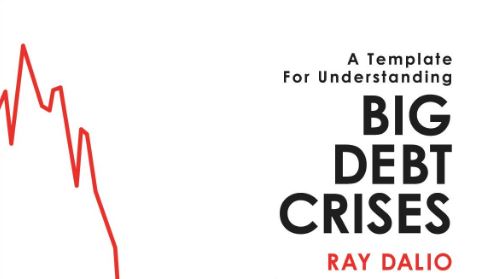Platinum's Investment Specialist Julian McCormack provides the principles for navigating big debt crises after reading 'A Template for Understanding Big Debt Crises' by Ray Dalio
Ray Dalio’s template is available free for download here: https://www.principles.com/big-debt-crises/
Initial thoughts on Dalio’s book
This is an impressive book. Dalio takes averages of various measures of economic performance across 47 debt crises, splitting these into reserve currency/deflationary debt crises and foreign currency/inflationary debt crises. In essence, the lessons are common-sense, but it’s valuable to see them set out thoroughly and simply in an accessible little book (60 pages in the main part of the book, with over 200 pages in case studies and appendices thereafter).
The charts in the book are terrific – it is worth downloading and perusing just for these, even if you are not inclined to read it.
In addition to describing debt cycles by using averages of many past episodes, Dalio questions the narrow, inflation-targeting mandates of most developed world central banks. He argues that they control money and credit, and so have the tools to address the formation of, and if need be remedies for, bubbles and subsequent debt crises. Further he makes the point that targeting current and near term inflation rates while ignoring the impact of debt bubbles and crises would appear to be a pretty blinkered view of inflation.
Dalio gives a simple framework for spotting bubbles:
- Prices are high relative to traditional measures
- Prices are discounting future rapid price appreciation from these high levels
- There is broad bullish sentiment
- Purchases are being financed by high leverage
- Buyers have made exceptionally extended forward purchases (e.g., built inventory, contracted for supplies, etc.) to speculate or to protect themselves against future price gains
- New buyers (i.e., those who weren’t previously in the market) have entered the market
- Stimulative monetary policy threatens to inflate the bubble even more (and tight policy to cause its popping)
There is acknowledgement of class dynamics in Dalio’s analysis. He clearly separates the incentives of capital owners and wage sellers. His chart of the shares of US wealth held by the top 0.1% versus the bottom 90% over the last 120 years is pretty amazing – spoiler: it’s about the same level now as in the 1930s.
Dalio’s thinking about responses to crises is very interesting. His key point is that the damage of crises is usually exacerbated by a lack of understanding and response by policy makers, often held back by noble fears of moral hazard and/or lack of legal-financial tools to deal with the effects of crises and stem the bleeding.
“…the two biggest impediments to managing a debt crisis are: a) the failure to know how to handle it well and b) politics or statutory limitations on the powers of policy makers to take the necessary actions. In other words, ignorance and a lack of authority are bigger problems than debts themselves.”
When confronted with a debt crisis, policy makers have the following tool kit:
- Curtail panic and guarantee liabilities
- Provide liquidity
- Support the solvency of systemically important institutions
- Recapitalize/nationalize/cover losses of systemically important financial institutions
As a guiding principle, policy makers should go hard, early and in a coordinated manner when stimulating, devaluing and providing liquidity in response to a debt crisis.
Dalio makes the point that printing money in a crisis is not necessarily inflationary – it merely offsets the destruction of credit in the financial system (in the context of crisis). And policy makers must aim to get the nominal growth rate above the nominal interest rate if they have any hope of growing their way out of the situation.
Policy makers have three forms of “monetary policy” broadly defined:
- “Interest-rate driven monetary policy [which is ]… the most effective because it has the broadest impact on the economy;
- “Quantitative easing” (QE) as it is now called (i.e., “printing money” and buying financial assets, typically debt assets);
- [Put] money more directly into the hands of spenders instead of investors/savers and [incentivize] them to spend it.”
Another point made well is that one of the key principles for dealing with a non-reserve currency/inflationary crisis is to devalue hard and early. Get the currency cheap enough to be attractive at a given interest rate to foreign investors that it can stabilise, thus heading off inflationary expectations and a downward spiral.
Dalio doesn’t quite make the point that debt crises are not “debt” but “collateral” crises – i.e. if everyone who has borrowed a bit much and can’t repay has good collateral, the system is totally fine. If lending has been going into stuff that’s not worth what one thought, or is collateralized against stuff whose value collapses, then we have a problem. This point is implicit, but is not made explicit and I think it’s important in a world of deep-breathing about “global indebtedness” – debt will naturally go up over time, as a function of economic growth. The strength of the borrower, the lender and the collateral is what matters systemically (in my view).
A possible weakness of the approach in the book, and perhaps in Dalio’s thinking, is that economic growth is presented as a simple function of credit provision to an economy. Population growth, the impact of technology, reform programs, agrarian-urban demographic shifts and so on are all ignored.
Finally, another possible weakness is that Dalio does not touch on the idea that hyper-inflations, presented as a consequence of debt crises in countries without a reserve currency, are perhaps also the result of supply side shocks. In this interesting formulation, a supply side shock (like Zimbabwean farms being appropriated and productivity plummeting; or German industry collapsing post WW1) can lead to too much money chasing too few goods.
Such quibbles aside, this book is a must read for anyone interested in identifying a debt crisis. Furthermore it’s being given away for free by a great investor looking to add to his legacy by giving back some analysis and insight accrued over many years.

